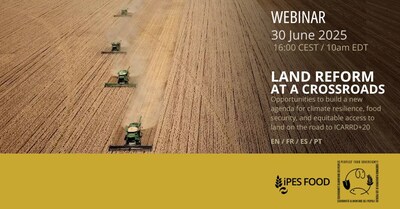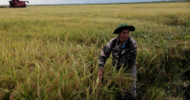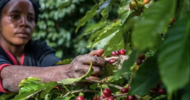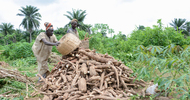GAI | 16 July 2021
How farmland fits in the investment portfolio of the future
How farmland fits in the investment portfolio of the future
By Lynda Kiernan-Stone, Global AgInvesting Media
We’ve all been through the wringer this past year. Looking back now, it’s common to feel it’s been almost surreal. Did all of that really happen? Then we realize that the fallout – economic, social, and personal – continues, and we are jolted back to reality.
We’ve all been put in positions and circumstances that were, until now, completely alien. But humans are nothing if not resilient (a key attribute to us being an alpha species on this planet – for better or worse!) and so we’ve pivoted and adjusted, and rapidly adopted new ways of achieving our goals.
This year Global AgInvesting also pivoted to great success, gathering for its 13th annual flagship event in the United States with a special optional golf tournament at the exclusive Sleepy Hollow Country Club, bringing together a preeminent group of ag investors, sector-focused asset managers, and agribusiness executives representing more than 245 organizations.
But now that we’ve conquered the “now”, what about the future?
At this year’s event, Oliver Williams, senior managing director, global head and CIO, agriculture investments for Hancock Natural Resource Group (HNRG) brought his extensive sector knowledge and experience stemming from managing the largest farmland investment portfolio at $3.7 billion in AUM across the U.S., Australia, Canada, and Chile to bear on the topic – how does farmland fit into the investment portfolio of the future?
According to the UN FAO, global food systems need to deliver 56 percent more food than today to meet the demands born of rising global populations and incomes. Indeed, by 2050 this demand will require an additional 20,500 trillion calories – and farmland investment will stand to fill this gap, noted Williams.
Like humans, farmland and agricultural investment will adapt and evolve to raise production volumes. This resilience has already been evident over the past 25-30 years through the dramatic increase in the number and variety of available fruits and vegetables, predicated on the ingenuity of producers, suppliers, processors, and scientists coupled with the flexibility of farmland – whether provided through conventional production, organic production, field systems, or from indoor growth spaces.
This flexibility is serving to not only meet needs in terms of volume, but also in meeting the additional demands being placed on our food systems by consumers expecting greater transparency in the supply chain, greater functionality in their foods, higher standards of sustainability, and greater consideration for animal welfare. A lot of this boils down to one conclusion – regenerative ag will drive the value proposition for farmers in the future, noted Williams.
In order to keep pace, there is a need to partner with new stakeholders, particularly in agtech, able to plug ag into the sustainable food and fiber narrative, change production practices, and secure partners able to provide the capital required to drive these technologies and changes.
“So as a bit of a stage-setter,” said Williams,”it really comes down to continuing in this track record of adaptation, leveraging technology and innovation, to position productive land to meet these changing demands.”
“We believe that further innovation is going to increase output,” continued Williams. “It will increase efficiency, and increase and expand the revenue potential – all while addressing sustainability of the system, which is now going to provide both financial and non-financial benefits.”
The number of deals and amounts of capital going into agtech, which is essentially the pipeline of innovation, is growing at an impressive CAGR of 12 percent. But nowhere is this growth and explosion of innovation more evident than in plant-based meat alternatives, noted Williams, which saw growth of 45 percent last year to reach a value of $1.4 billion – reflecting an extremely new, highly successful food category creating an opportunity to produce higher value crops on the farm.
“According to the USDA total factor productivity for farmland has increased three-fold over the last 70 years, and the conditions are really in place to see this continue going forward,” said Williams.
“Technology enables better profits, better risk management – these are just a few examples,” concluded Williams. “Different crops have different opportunity sets – it’s all about optimizing inputs and outputs, while managing the impacts at a sub-field level. And emerging technologies have the potential to continue this trend.”
In addition to emerging technologies, regenerative production practices are being widely adopted. For example, Indiana’s farmers planted a record 1.5 million acres of cover crops to protect the soil – a big leap forward. Processors are also joining the movement, noted Williams, with McCain, a major frozen potato product producer, committed to sourcing 100 percent of its product materials from farms employing regenerative ag production methods. This move indicates that regenerative ag adoption could be key to being able to access markets in the future.
Carbon capture and carbon markets also will be prominent features for farmers, however, issues remain with measuring, recording, monetizing, and standardization, while ESG and sustainability remain leading demand from the consumer side of the equation. Another window of opportunity for today’s farmers lies in clean energy – solar, wind, and hydropower, as the U.S. government has announced its target for 80 percent of the country’s energy to be sourced from renewable sources.
“Looking ahead, we believe that farmland will benefit from filling the food gap; will benefit from the increased focus on health and wellness, and it has the opportunity to deliver food and fiber sustainably to really meet consumers’ demands and requirements,” concluded Williams.
“This is going to be supported by the suite of technologies being well-understood and being adopted. It’s also going to change as innovations that are in the pipeline start to emerge.”













